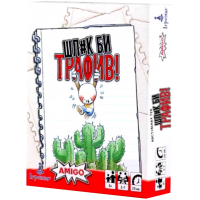No Thanks! Board Game Review
Related Products
BOARD GAME REVIEW NO THANKS!
In the game "No Thanks!" players try not to draw cards from the center of the table, paying for the privilege by placing one of their 11 starting chips next to the card. During a table game, chips accumulate until one player decides to take a card (and all chips) or is forced to take a card because they are out of chips.
"No Thanks!" contains a deck of 33 cards numbered from 3 to 35 and 55 game chips.

PREPARATION FOR THE GAME
To prepare "No Thanks!" , deal 11 chips to each player and return the remaining chips to the box. Shuffle the cards and draw 9 cards at random by placing them in the box without looking at them.
GAME PROCESS
In "No Thanks!" the first player reveals the top card of the deck. After that, the player must choose whether to place the card in front of him or place the chip next to the card and pass it; "No, thank you." Play then proceeds clockwise to the next player, who must make the same choice: pass or take. Continue like this until one player takes the card in the middle (along with all the chips), either by choice or because they are out of chips.
The player who takes the card will also be the player who turns over the next card in the next round with the same set of decisions. Play continues in this manner until the last card is turned over and taken.
RECEIVING THE CARD IN NO THANKS!
Taking a card in "No Thanks!", the player places this card face down in front of him, a little further away from the other cards.
At the end of the game, each individual card is worth as many points as the face value of that card.
Cards grouped together in a continuous numerical sequence are worth the value of the youngest card in the sequence. In the following example, only 19 will be worth points at the end of the game.

Gaps between individual cards (and even grouped cards) count as a space and will cause the lowest card in each group to score a point. In the following example, both 19 and 23 will count against the player.

A great strategy is to do your best to take cards that are already only 1 or 2 different from your other card. Then try to combine them together with another card. A player with this configuration of cards risks but can also be rewarded if he secures 21, 22 and/or 24.

Any chips left in front of you at the end of the game are deducted from your score, so do your best to have plenty of chips as the game draws to a close.
The player with the fewest points at the end of the game is the winner.
WHAT I LIKED ABOUT THE GAME
"No Thanks!" , simply put, a fun game. I like No Thanks! because it's fast-paced, has a moderate amount of strategy mixed with a bit of luck and uncertainty, and is extremely easy to learn. Bonus points for so few components and portability.
WHAT I DIDN'T LIKE
The only thing I don't like about No Thanks! is the box. It comes in a standard two piece box that doesn't close very well for my copy. This forces me to put a rubber band on the box to keep it closed. This does not affect the game process and is a purely cosmetic nitpick.
CONCLUSION
In my opinion, the trifecta of criteria for small box card games is:
- Easy to teach
- Plays fast
- A lot of fun
When you get a card game that has these 3 aspects, you are sure to have a winning game in your collection. And that's what "No Thanks!" is a winner!





